
Department of Pediatrics, Graduate School of Medicine, Hokkaido University
Atsushi Manabe, M.D., Ph.D.Specialized Medicine
- Education and positions:
-
- 1979-1985
- School of Medicine, Hokkaido University
- 1985-1989
- Department of Pediatrics, St. Luke’s International Hospital (Pediatric residency)
- 1989-1990
- Division of Pediatric Oncology, Catholic University of Rome
(Italian governmental fellowship) - 1990-1993
- Department of Hematology-Oncology, St. Jude Children’s Research Hospital in Memphis, USA (Post-doctoral fellowship)
- 1993-1997
- Department of Pediatrics, St. Luke’s International Hospital
- 1997-2004
- Department of Pediatric Hematology/Oncology, Institute of Medical Science,
University of Tokyo (Assistant professor) - 2004-2019
- Department of Pediatrics, St. Luke’s International Hospital
(Chief in Pediatric Hematology-Oncology) - 2015-2019
- Research Center, St. Luke’s International University (Clinical Professor)
- 2019-present
- Department of Pediatrics, Graduate School of Medicine, Hokkaido University (Professor and Chairman)
We are able to provide medical care for any childhood diseases and disorders.
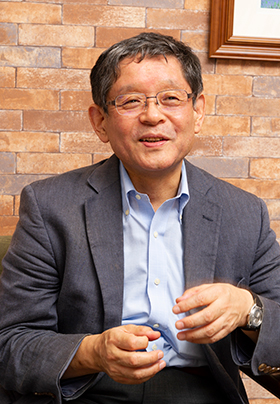
The Department of Pediatrics in the Graduate School of Medicine at Hokkaido University suddenly drew public attention when the department conducted the first successful gene therapy in Japan in 1995. The two young patients who were treated with the world-leading gene therapy at that time have recovered from their diseases and have grown up to be college students. The Department of Pediatrics has a significant presence among a variety of pediatric fields, and Professor Atsushi Manabe has been in charge of the management of the department since April 2019 as the seventh leader of the department.
The number of intractable pediatric diseases treated at university hospitals is small (the annual number of childhood cancer cases is 2,000 in Japan, for example, from a total of one million cancer cases). However, pediatric diseases come in a variety of forms [1] and many of them are congenital diseases. Pathogenesis and treatment of pediatric diseases are different from those of adult diseases. Professor Manabe proudly says, “The Department of Pediatrics is capable of treating any pediatric diseases.”
More than 40 staff members and graduate students of the Department of Pediatrics form 10 groups[2] of different medical fields and provide medical care in a self-disciplined manner using their highly specialized knowledge and skills. Some of the groups also serve as the research groups of the Initiative on Rare and Undiagnosed Diseases[3] (IRUD) launched by the Japan Agency for Medical Research and Development (AMED) and collect clinical data on inherited disease which is not always familial as well as promoting research on diagnosis and medical treatment. Thus, they are involved in research in a wide range of topics.
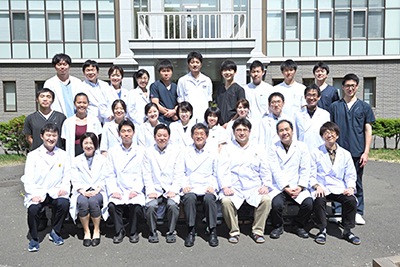
Professor Manabe recalls, “Soon after taking up the post as the professor of the department, I organized laboratory equipment and instruments that are used exclusively by the groups so that the laboratories are ready to be used by anyone.” In addition to ward rounds, ward management, training and the guiding of young physicians and other daily duties, the professor, as the leader of the only government-designated core hospital for childhood cancer in Hokkaido, supervises relevant hospitals in the prefecture. He has also created a mailing list of young physicians working at two medical universities, the cancer center and other facilities in Hokkaido in order to share patient information online and hold conferences regularly, thereby enhancing cooperation for childhood cancer care in Hokkaido.
The professor is highly motivated to conduct joint research with other departments and divisions in the university. “The main focus of my previous work was providing medical care, so I am pleased, above all, with my current work environment that allows us to carry out multidisciplinary research with researchers and professors in other fields,” the professor says. “We are involved in the development of new treatments with physicians at the Department of Nuclear Medicine, Hokkaido University Hospital, and we also proposed a joint research project on photoimmunotherapy for childhood cancer to physicians at the Faculty of Pharmaceutical Sciences of Hokkaido University,” he adds. “Furthermore, collaboration with the Institute for Genetic Medicine in Hokkaido University and the departments of internal medicine is expected to lead to new discoveries in the research of new diseases and treatments. For example, when we followed up a child with congenital kidney disease, it turned out that the child developed pancreatic cancer at the age of 10. Thus, childhood diseases can easily develop, crossing the borders of medical specialties. In this sense, pediatrics departments need to collaborate with other medical specialties.”
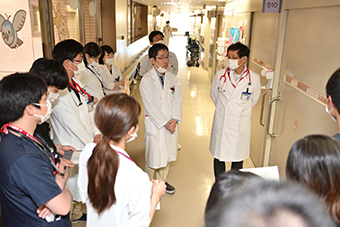
Another reason why Professor Manabe puts emphasis on multidisciplinary collaboration is his belief based on his experience as a family doctor who had long studied the pathophysiology of diseases in many patients.
In September 2019, Professor Manabe and other doctors established a pediatric/AYA (Adolescent and Young Adult) cancer center in Hokkaido University Hospital for patients in childhood (under approximately 15 years of age), when rare cancers are likely to develop, as well as in adolescent ages and young adulthood (15 – 39 years of age). A team approach involving physicians from various departments, nurses, social workers, and other professionals was started in an effort to support patients in receiving medical care over a long period of time, getting education and jobs, and experiencing other life events during, before and after their treatment phase.
Professor Manabe on the other hand points out a delay in transitional care (to support transition from childhood care to adult care) in Hokkaido. The professor says with an eye to the future, “Actually, there are some adults with diseases from childhood who still see their pediatricians and receive care in pediatric wards into their 30s. Accordingly, our next goal is to establish a Transitional Care Center in Hokkaido University Hospital to facilitate the follow-up of patients in transitional care in cooperation with other departments.”
Research papers in the field of pediatrics research are likely to be accepted by famous journals.
Specializing in childhood cancer, Professor Manabe has clarified the genetic background of leukemia development through the genomic analysis of acute lymphocytic leukemia (ALL) patients, the most common type of childhood leukemia. Meanwhile, in the research of myelodysplastic syndrome (MDS) that he has conducted as his lifetime’s work, he has been involved in cytogenetic analysis to explore the background of MDS development in children with down syndrome, Fanconi anemia or other congenital predisposition. All this research is carried out as nationwide joint projects.
Professor Manabe is one of the members who established Japan Children’s Cancer Group (JCCG), which intensively collects data on the pathology of childhood cancer from across the nation to conduct DNA diagnosis and clinical research. “JCCG has more than 10,000 cases of clinical blood data alone. Collecting data on rare cases in one place helps us conduct international joint research and obtain research funding easily. In fact, there has been a remarkable progress in childhood cancer treatment by sharing data globally and promoting joint research. Research papers on childhood diseases are likely to be accepted by famous journals because most childhood diseases are rare, and there may be countless findings,” he explains.
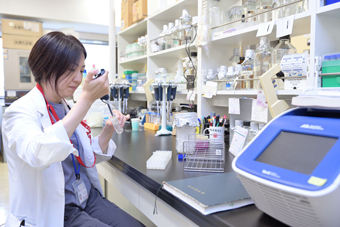
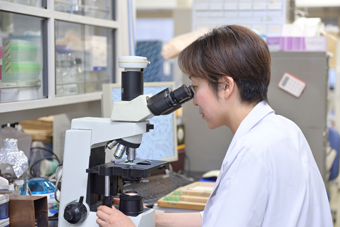
At the Department of Pediatrics, most of the young physicians who constantly address pediatric diseases, about which we have limited information, go on to graduate school, and currently 23 members are involved in a wide range of research.
“Last year, a graduate student in the Endocrinology Group figured out a significant part of the causes of hypothyroidism (cretinism), which is one of the congenital diseases characterized by insufficient hormone production from the thyroid gland,” Professor Manabe says. “A graduate student in the Immunology Group conducted genetic analysis based on data from only several cases available across Japan and discovered that one of the reasons for deficiency in folic acid, an essential nutrient for a rapidly developing fetus, is an inherited disease, which is not always familial (hereditary folate malabsorption: HFM). A staff member of the Neonatology Group found out that some cases of congenital pulmonary alveolar proteinosis in newborn babies may be complicated with immunodeficiency.”
In terms of collaboration with other departments and divisions, “A graduate student of the Cardiology Group, in cooperation with a department of the Faculty of Pharmaceutical Sciences that is involved in the development of nanocapsules targeting mitochondria, is exploring a method using nanocapsules to reduce the adverse effects of anticancer drugs on the heart,” he adds.
Professor Manabe admires and encourages the passion of young people involved in these unique research projects. “I hope that our staff members will devote themselves to clinical services and become physicians who are capable of serving as the heads of research group meetings in their areas of specialties and will eventually lead Japan,” he says. “It is important to acquire added value useful in hospital. I recommend young physicians to obtain a license to practice specialist medicine specializing in clinical genetics, infectious diseases control or other specialist services.”
(Interviewed in August 2020)
[1] ^ For a grant-in-aid program for chronic diseases in childhood based on the Child Welfare Act, 762 diseases are classified into 16 groups by target diseases, namely 1) malignant neoplasm, 2) chronic kidney diseases, 3) chronic respiratory diseases, 4) chronic cardiac diseases, 5) endocrine diseases, 6) collagen diseases, 7) diabetes, 8) congenital metabolic disorders, 9) blood dyscrasia, 10) immunologic diseases, 11) neuromuscular diseases, 12) chronic digestive disorders, 13) syndrome with changes in chromosomes or genes, 14) dermatosis, 15) systemic bone diseases, and 16) vascular system diseases. In Hokkaido, there are approximately 4,000 applicable patients.
[2] ^ A total of ten groups: Immunology, Infectious Disease, Hematology-Oncology, Neurology , Nephrology, Endocrinology/Diabetes, Cardiology, Neonatology, Genetics, Metabolic Disease/Gastroenterology groups.
[3] ^ Undiagnosed diseases: Diseases with symptoms which cannot be diagnosed by general medical institutions and whose treatment is yet to be discovered.
The professor is a virtuoso of the Pediatrics Ward

Professor Manabe is a virtuoso pianist, and his motto is “Read books, make friends and have hobbies while you are a student.” He is a virtuoso of the Pediatrics Ward, who also composes music, used to play the clarinet in the Hokkaido University Symphony Orchestra when he was a student, and still enjoys playing in an ensemble with students. In the playroom at the Pediatrics Ward, music (composed by Professor Manabe) played by a koto (Japanese harp) player, who is a friend of Professor Manabe’s from his high school days, and the melodies of “Silent Night” played on a clarinet help children develop sensitivity.


